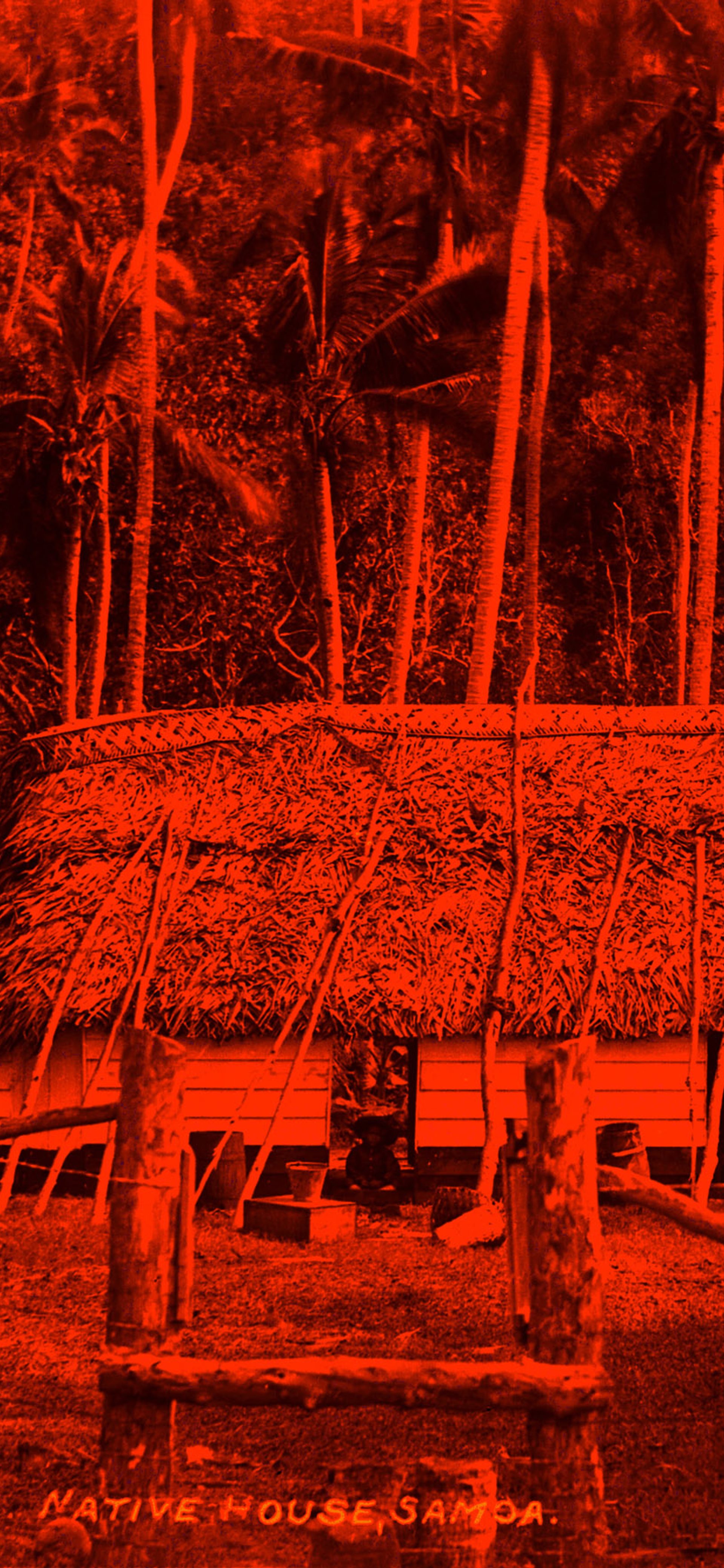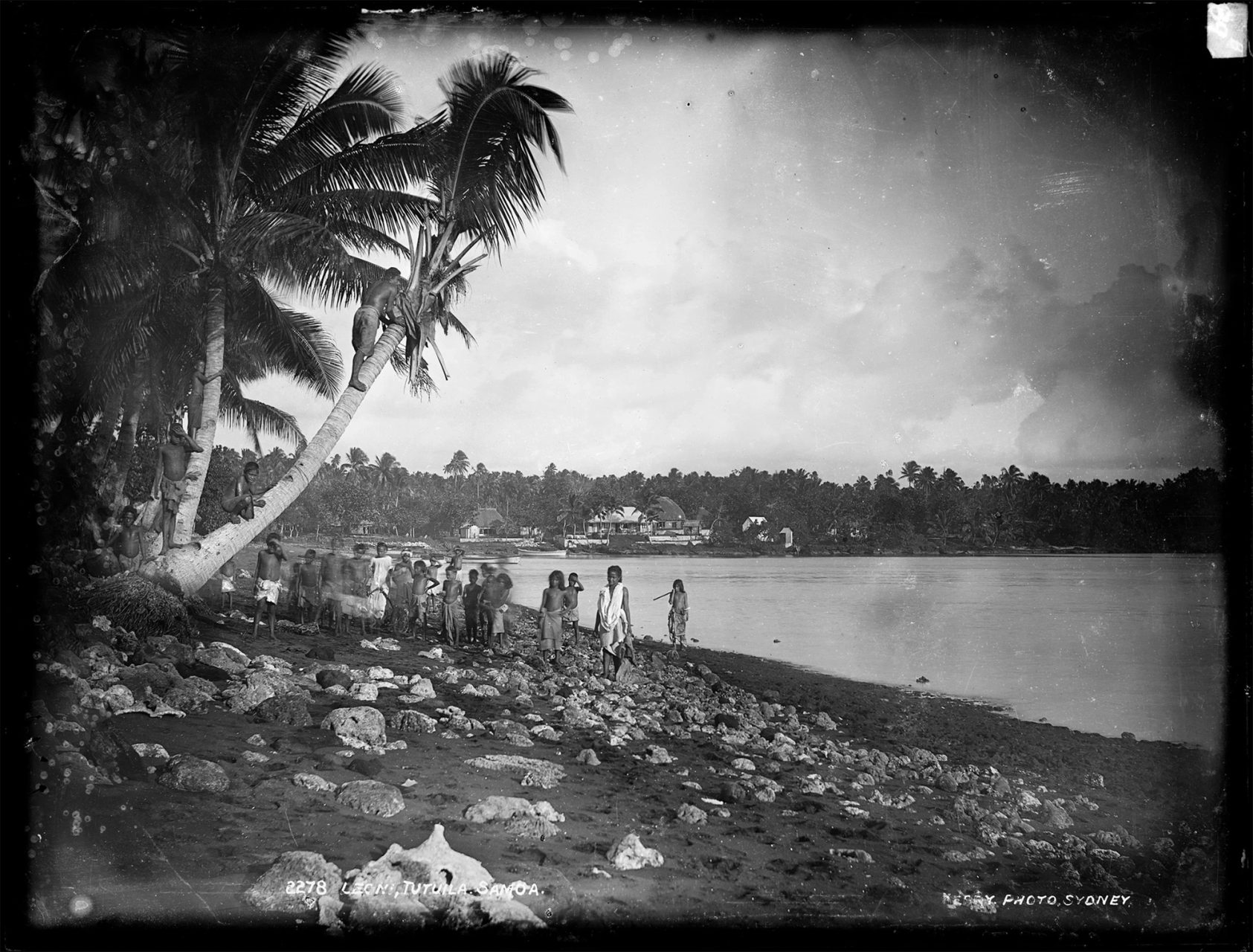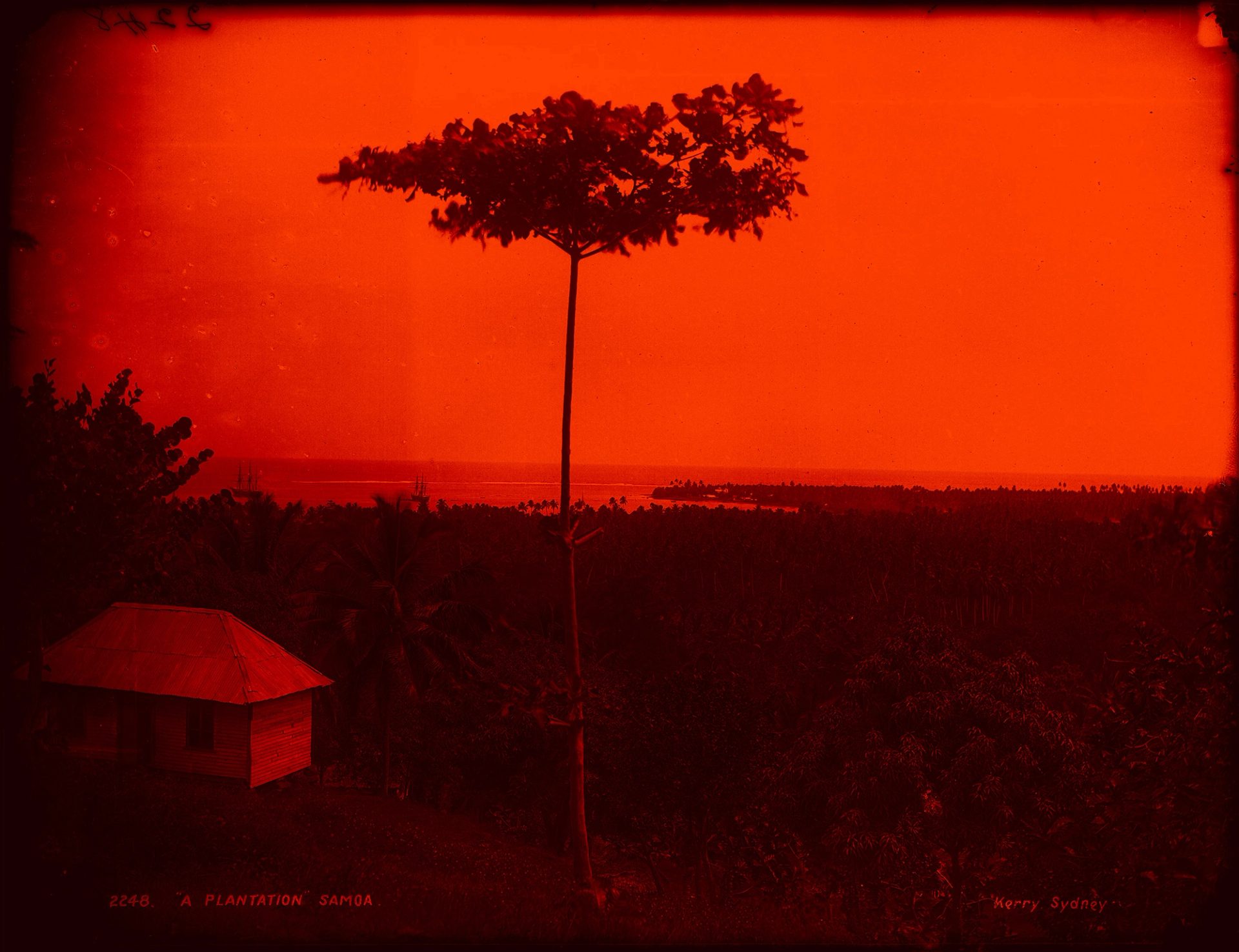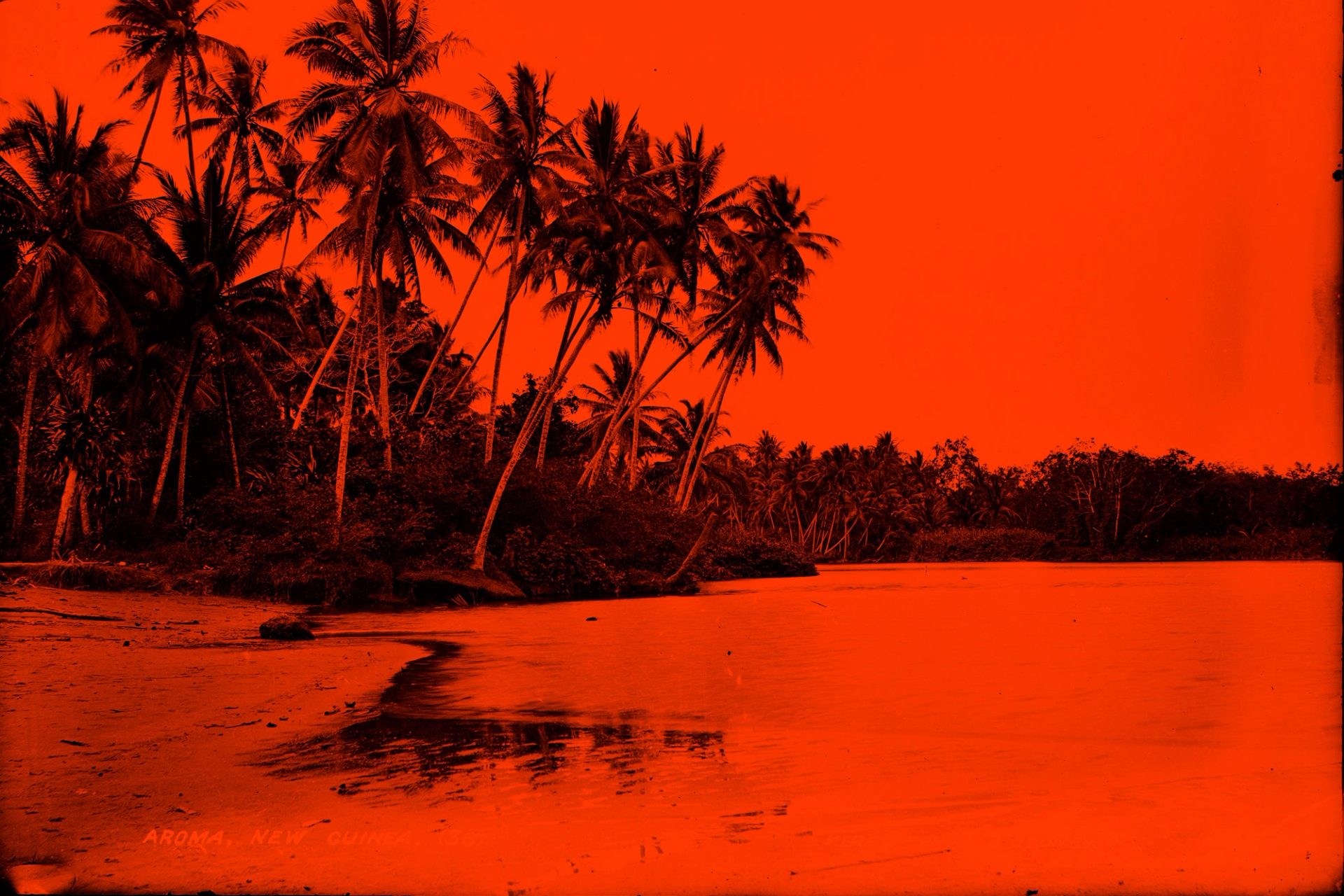Arts in the Sāmoan Diaspora

Half the world's population of Sāmoans live in the diaspora and the arts is an integral part of maintaining connections to the homeland, forming identity, and responding to social and political environments.
Listen to, or read, provocations by Ioana Gordon-Smith and excerpts of responses from Lalau Leo Tanoi, Jannike Seiuli, Tau'ili'ili Alpha Maiava and Tiumalu Noma Sio-Faifumu as they explore the comparison and politics of ‘Sāmoaness' in art within the Sāmoan diaspora of Aotearoa New Zealand and Australia.
Ioana Gordon-Smith
‘Holding multiple identities and multiple sets of relations often means being caught in the invisible gap between pre-established identities: being too palagi to be fully Sāmoan, too Sāmoan to be palagi, and not Indigenous to the lands that we live within.’
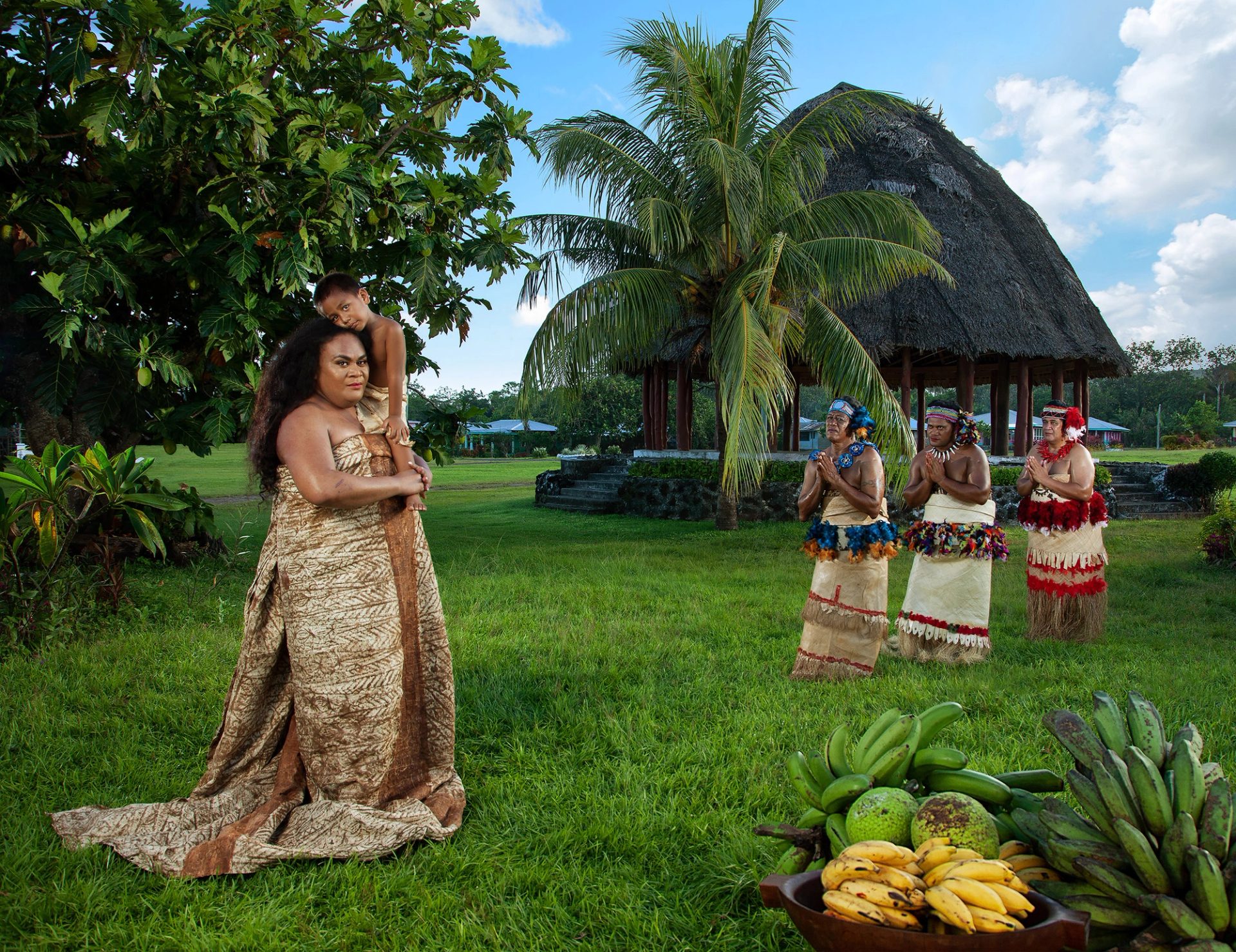
Ioana Gordon-Smith My name is Ioana Gordon-Smith, and I am one of over half a million Sāmoans who live outside of Sāmoa. My mum, from the villages of Faleula and Le'auva'a migrated to New Zealand in the 1970s. My dad, from England, migrated to New Zealand in the 1960s, and I was born and raised in Aotearoa and currently live in Cannons Creek in Porirua. I'm also a lead curator at Pataka Art Museum, and last year I had the enormous pleasure of being the assistant curator Pasifika for Yuki Kihara’s Paradise Camp at the 59th Venice Biennale. Working with Yuki has really given me the image of an artist who has lived a very complex global life, who has lived for various periods in Sāmoa and New Zealand and in Australia, and who has travelled the world through exhibitions and residencies. And I think Yuki's history of all these movements and returns offers a really complex context for today's talanoa sessions and my provocations on the diaspora.
So, I want to offer two sets of thoughts or provocations. But the first thing that I wanted to put into the room today was the notion of Sāmoa's many guises. Paradise Camp here at Powerhouse Museum looks slightly different to how it looked at the Venice Biennale. For one thing, there's this huge luxe ocean scape on the floor. There are archival images and people that have come out of the Powerhouse Collection, and there's a brand-new commissioned work.
BERTHA is a series of repurposed vintage dolls that have been adorned with miniature versions of costumes worn by the legendary Harold Samu, also known as Bertha. Each doll marks a significant moment in Bertha's life. Law Reform Girl, for instance, showcases a jacket that Samu wore while marching for gay rights down Queen Street in Auckland and Door Bitch marks Bertha's move to Sydney and the involvement of fa'afafine in performing and fundraising within this context. And the most recent work or Pacific couture outfit is Over the Rainbow, which features a contemporary take on the Sāmoan tuiga. And why I think this work is so interesting is because it really expands Paradise Camp's focus on fa'afafine realities in Sāmoa, when it was presented in Venice and resituates it to acknowledge a transnational network of fa'afafine. The work really reminds us that Sāmoans and fa'afafine live all over the world, and I think that's a kind of acknowledgment of the fact that there is a local diaspora audience here in Sydney.
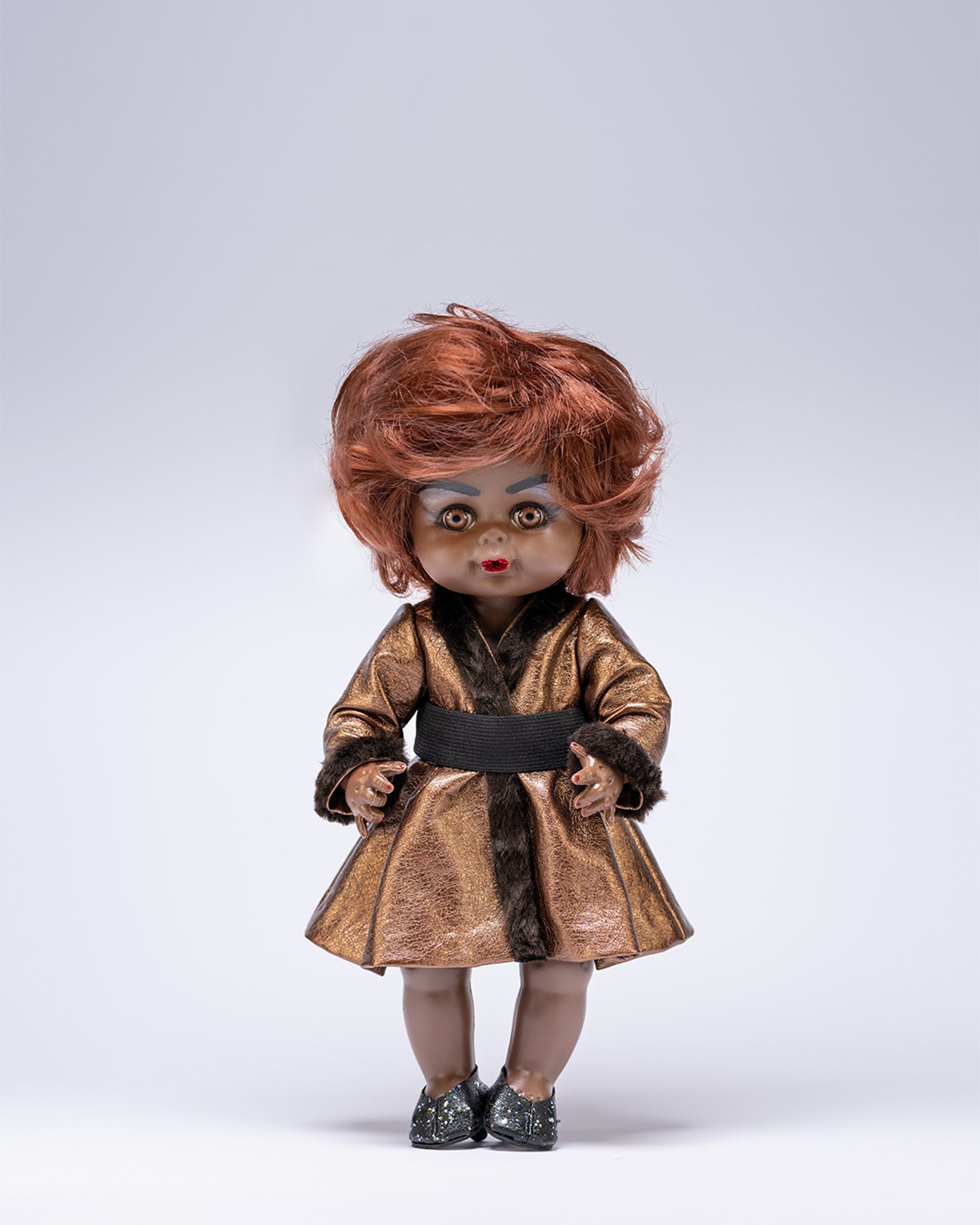
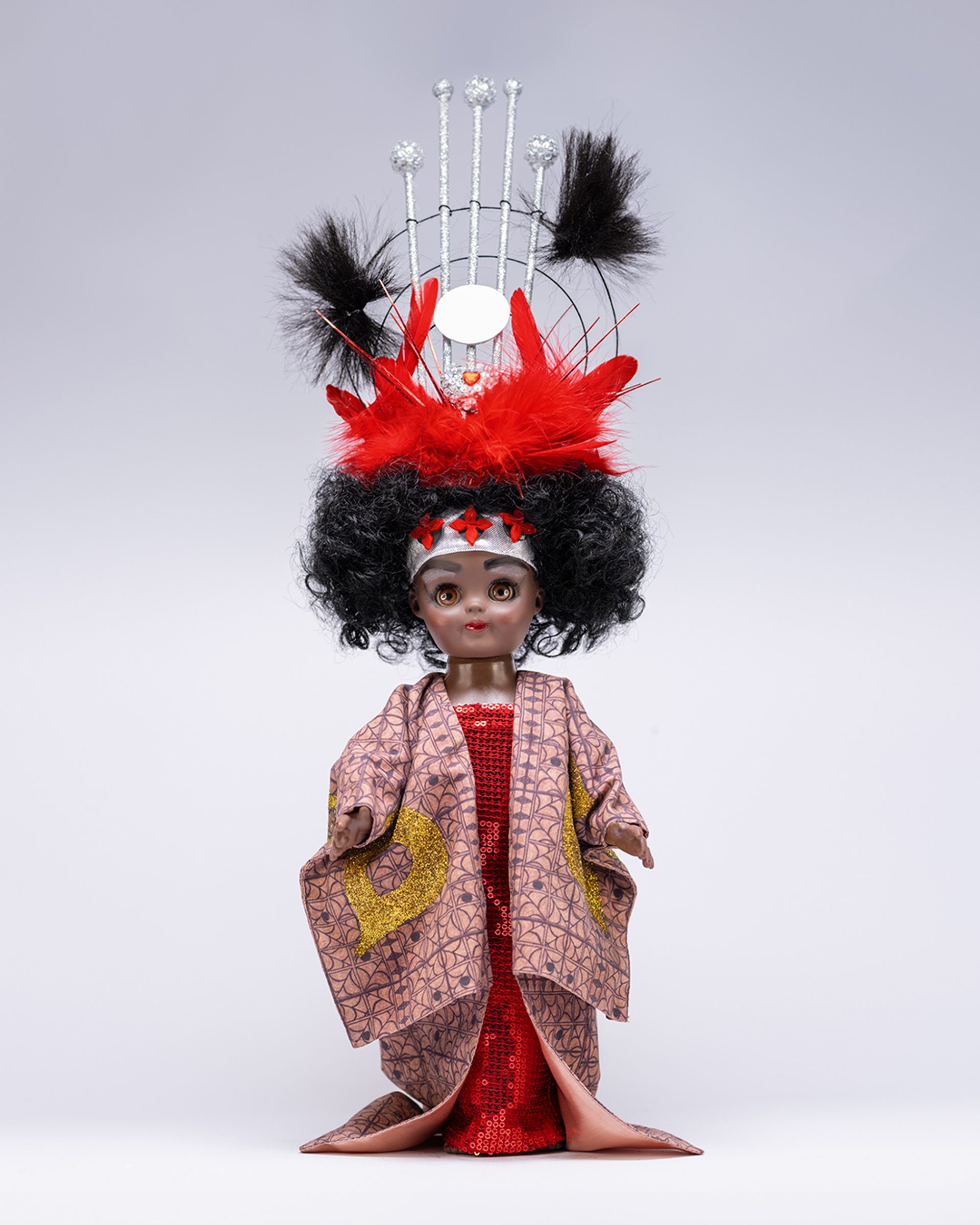
And I wanted to focus a little bit on the diaspora. And apologies, as a Sāmoan heritage person who's only lived in Aotearoa, a lot of my experiences are specific to that context. So, the Sāmoan diaspora has been a key scholarly and artistic topic for the last 40 to 50 years, following closely in the wake of different migration waves. And so, from a small migrant community in the 1940s, New Zealand's moana population significantly increased over the last seven decades. During the 1950s and 1960s labour shortages in New Zealand prompted the kind of mass influx of migrants from around the moana.
Tens of thousands of Sāmoans and Tongans migrated to New Zealand by way of work visas, while New Zealand's Cook Islanders and Tokelauans could travel to New Zealand as citizens of New Zealand's Pacific outposts. Today, however, more than half of New Zealand's moana population and over two thirds of its Sāmoan population are New Zealand-born. So, while labour shortages fuelled the initial waves of migration and diaspora in New Zealand, its population now mostly emerges from natural birth rates. Navigating how Sāmoan identity is reproduced, adapted and fashioned away from Sāmoa has been a recurring theme of Sāmoan arts in Aotearoa.
At its basis is the fact that being Sāmoan in Aotearoa is slightly different to being Sāmoan in Sāmoa. Pacific Studies scholar Damon Salesa notes that while New Zealand's Sāmoan experiences aren't universal, we can identify some trends. So, New Zealand Sāmoans, but particularly New Zealand-born Sāmoans, are perhaps more likely to speak English as their first language, less likely to identify as religious, and more likely to claim more than one ancestry. We're also less likely to have access to customary materials – there's a history of import bans on them – predominantly young, and often concentrate in urban areas. That doesn't mean that an attachment to Sāmoan identity or ancestral roots has been in any way diminished. You only need to look at the kind of spectacle of the 685 parades ('685' is the country dialling code for Sāmoa), which were particularly thriving in Cannons Creek, to know that a pride in Sāmoan identity remains strong. But the forms and modes of transmission of Sāmoan identity might look a little bit different in New Zealand.
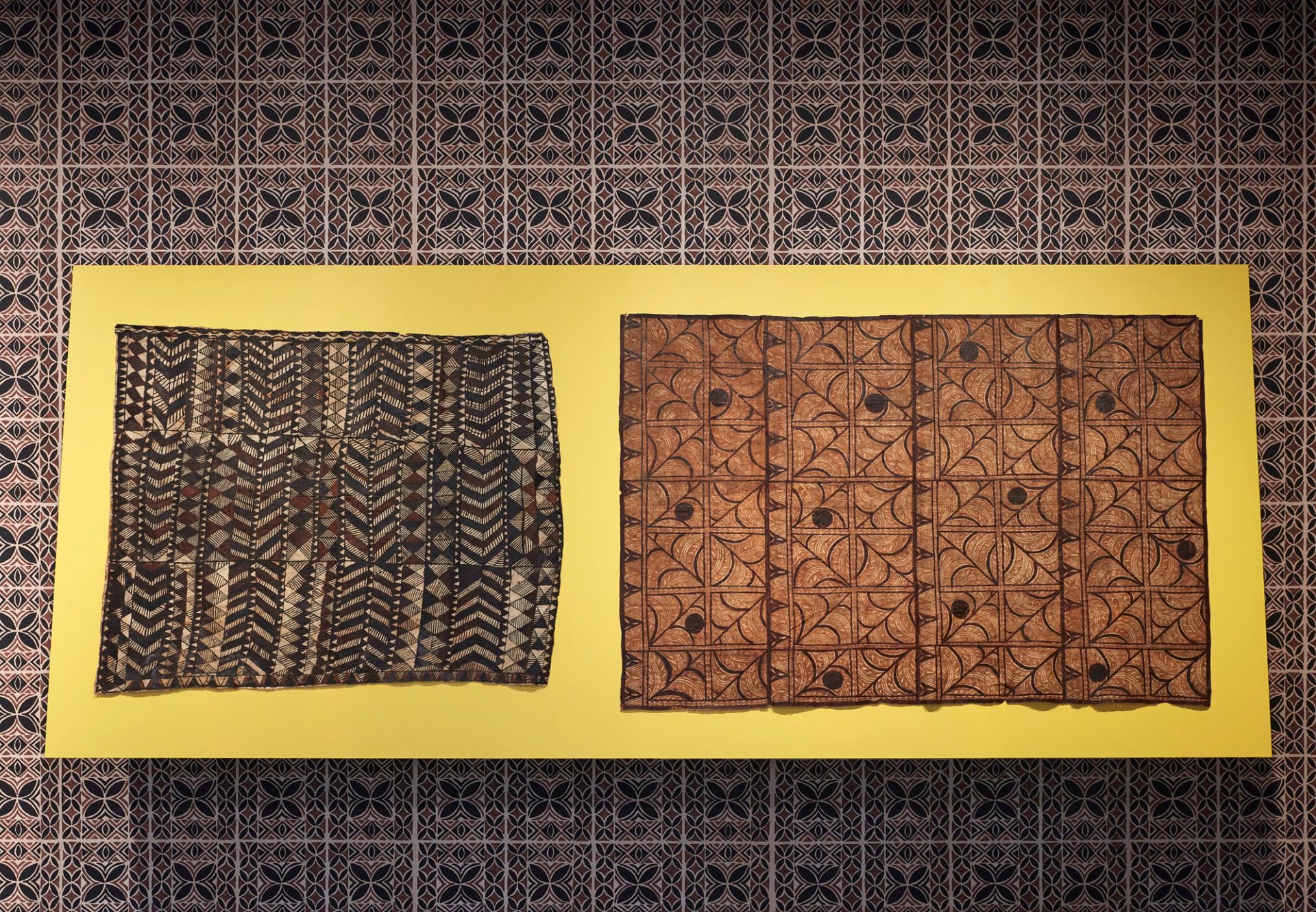
As Sāmoan spatial design scholar Albert Refiti notes, ‘Although customs may not be performed exactly as they are in some way, we nonetheless coiled them into concepts, carry them in a toolbox of theory, then unpack, operate, and perform them when required’. Just as fa'a Sāmoa looks slightly different in diaspora, so too does being Sāmoan in Aotearoa introduce a new set of relations, and there are three that stand out in particular to me.
The first is a new relation with the Indigenous peoples whose lands we live on. So, in Aotearoa, mana relations with Māori are twofold. On the one hand, we share a kinship, a shared ancestral connection to Te Moana nui a Kiwa. But on the other hand, we're also in New Zealand as tauiwi or guests. Not here necessarily at our Māori cousins' requests, but in response to the needs of the New Zealand economy, and a new relation between moana and Indigenous peoples is kind of produced everywhere that moana peoples migrate.
The second set of relations is with other moana peoples. Sāmoan writer Albert Wendt once joked that it is only when he walks through the international terminal at the Auckland Airport that he becomes Pacific; elsewhere, he is simply Sāmoan. And his quip observes the fact that regional identities take on a greater emphasis and importance in diaspora, where they are embraced as a form of solidarity based on a shared connection to the moana. In New Zealand, the kind of grouping of different migrants from island nations and their descendants has even earned its own official government term: Pasifika.
And the third provocation that I want to put into the room is a response to a different set of colonial conditions of being a minority within a settler colony, where histories of the dawn raids and race baiting news coverage consistently remind us that we're not from here. Being Sāmoan diaspora in Aotearoa is kind of marked by this complex set of conditions, of being slightly distanced from the Sāmoan context of ongoing pride and ancestral attachments to being Sāmoan, and a new context with really specific sets of relations. Moving between all of these different factors, diaspora Sāmoan artists have often had to fight for visibility within their adopted homes. Holding multiple identities and multiple sets of relations often means being caught in the invisible gap between pre-established identities: being too palagi to be fully Sāmoan, too Sāmoan to be palagi, and not Indigenous to the lands that we live within. As New Zealand artist John Bull once put it, ‘I'm nearly everybody's other’.

I think, Paradise Camp returns visibility to a local diaspora audience. And when it comes to acknowledging fa'afafine diaspora experiences in this iteration of Paradise Camp, it makes sense to me that Yuki would include something with an element of fashion. That's not only because she trained in fashion, but because fashion has been a key marker of identity in the diaspora and for Pacific peoples. As I walked in today, I was just amazed at how everyone looks. So, you only need to look around at how beautiful we all are to know that that's quite true. In her essay, Brown and Bougie, Sāmoan writer Lana Lopesi notes that fashion is important for those of us in the diaspora in many different ways. It is simultaneously a mode of protest, a resistance to assimilation, as well as being part of identity formation and construction. It's also about continual evolution, constantly finding new ways of being.
Within diaspora arts in Aotearoa fashion has definitely been an early vehicle for developing new ways of being Sāmoan. In the 1990s, while mainstream representation largely ignored the thriving diaspora, creativity, happening nightclubs and theatres and fashion shows like Star Pasifika were sweltering with moana creativity. From Lindah Lepou's Pacific couture and the Pacific Sisters' urban pasifika garments and performances, through to Siliga David Setoga's line of subversive T-shirts, fashion has always been a place where the diaspora has expressed distinct, Aotearoa bred Sāmoan realities. So, fashion histories, I think, can really counter the invisibility of the diaspora to remind us that moana peoples have always been creating and collaborating. But the kind of new expressions of Sāmoan identity haven't been without controversy. Backlash has often come with works that have been perceived as risqué or critical of fa'a Sāmoa. More and more pervasively, the diaspora is often dogged by questions of authenticity. Questions of whether one can speak the language, dance the siva, weave the ie tōga, often lurk like snake attacks in the shadow.
Heated debates around authenticity predictably crop up on Twitter all the time, usually around conversations of how fa'a Sāmoa practices, like tatau are practiced and operate in the diaspora. Albert Wendt has consistently argued against notions of authenticity and tradition, noting that to pinpoint a kind of pure oceanic culture is impossible. It too, has always been evolving, and worse, it fixes Oceania into a false moment of stasis. Essentialising an idea of Sāmoan identity, culture and art also removes all possibility for debate and dissent.
To return to the BERTHA series again, challenging and educating our own sometimes very conservative communities is incredibly important. I'm really lucky that I live and work in Aotearoa at a time where we've had multiple generations of artists often overlapping, often expanding what it means to be Sāmoan and diaspora. So, in the 1980s, you had ground-breaking artists like Fatu Feu'u all translating siapo, tatau, weaving and Lapita pottery into painting and printmaking mediums. In the 1990s, you had moana artists considering how art and identity is influenced by urban contexts. And in the 2000s, another generation of artists were considering how identities, including Sāmoan identities, are constructed, mediated and performed through digital technology.
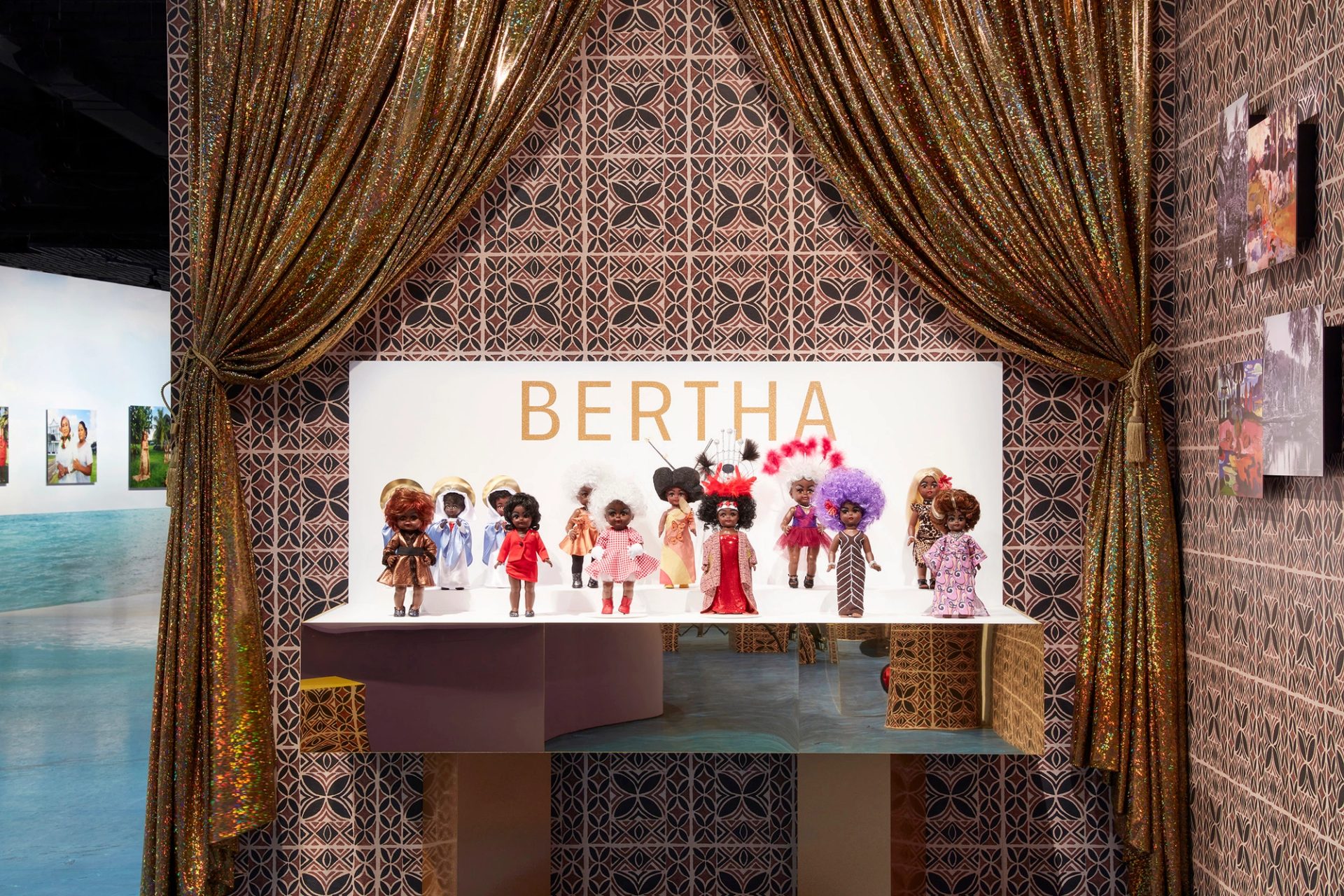
Each successive wave of moana artists and diaspora has added more nuance and more options and more detail about how we understand Sāmoan identities in Aotearoa. After three plus generations of diaspora art, we've come to understand how moana identities and art practices are developed at the intersection of ancestral roots and transnational roots. As the diaspora grows, so do the permutations of those intersections. There are nuanced differences, for instance, between being Sāmoan in Porirua and Sāmoan in Invercargill; between being first or second generation Sāmoan New Zealanders; and across the spectrum of class, sexuality and colour. Those differences and nuances are echoed in how Sāmoan artists relate to identity in their art. Some artists invest in return journeys and in reawakening practices. Other artists adapt concepts and practices to new environments and materials. And others still refuse to perform Sāmoan identity in their work at all. All of those approaches are valid. There is a diversity in diaspora, a diversity in ways of being Sāmoan. Wendt argues that Oceania has and always will assume new guises. ‘The love affair’, he writes, ‘is endless’, and I have to admit that I'm in love, too. I'm in love with all the different versions of Sāmoa that appear across the arts. And so, my first question that I want to ask is, how do we recognise a Sāmoa and a Sāmoan art history that has many guises spread across the world?
My second provocation that I want to pose relates to mobilities. Diaspora is often framed between two poles, between ancestral homelands on the one hand, and adopted homelands on the other. But diaspora peoples continue to move beyond their adopted homelands. We know that anecdotally, through families who have moved from Sāmoa to New Zealand and then moved on to Australia, or through the number of moana sports people living in New Zealand and Australia who go on to play in Italy or France. And we see it too, actually, in Bertha's story of moving from Aotearoa to Sydney. And someone really needs to do research about the connection between Sāmoa and South Korea. Drawing attention to those additional movements, additional migrations, I think, is key to understanding a slight asymmetry that exists within the art world.
By and large, the Sāmoan diaspora is afforded greater access to mobility and movement than those artists living in Sāmoa. Citizenship and wealthy settler colonies like New Zealand, Australia, and the United States affords diaspora greater legal access to migration and travel through formal mechanisms like a globally well-regarded passport, easier access to visas and qualifications that are more readily recognised within global markets. That's also supported by greater access to funding arts agencies, funding pools and established contemporary art institutions that legitimise art as contemporary are also more available to moana artists in the diaspora.
Consequently, the representation of modern art, particularly within global circuits, is often skewed towards diaspora artists. For example, the earliest international exhibitions of Pacific arts such as Paradise Now Contemporary Art from the Pacific at the Asia Society Museum in 2006, and Dateline Contemporary Art from the Pacific in 2007. Both claimed to survey Pacific art from the region, but both of them were either dominated by or exclusively featured artists from New Zealand. Sāmoan art, when it comes to the global art world, is often represented by its edges. As such, skewed representation reinforces a common but very false preconception that art made in the diaspora is contemporary, while art made in Sāmoa is customary.
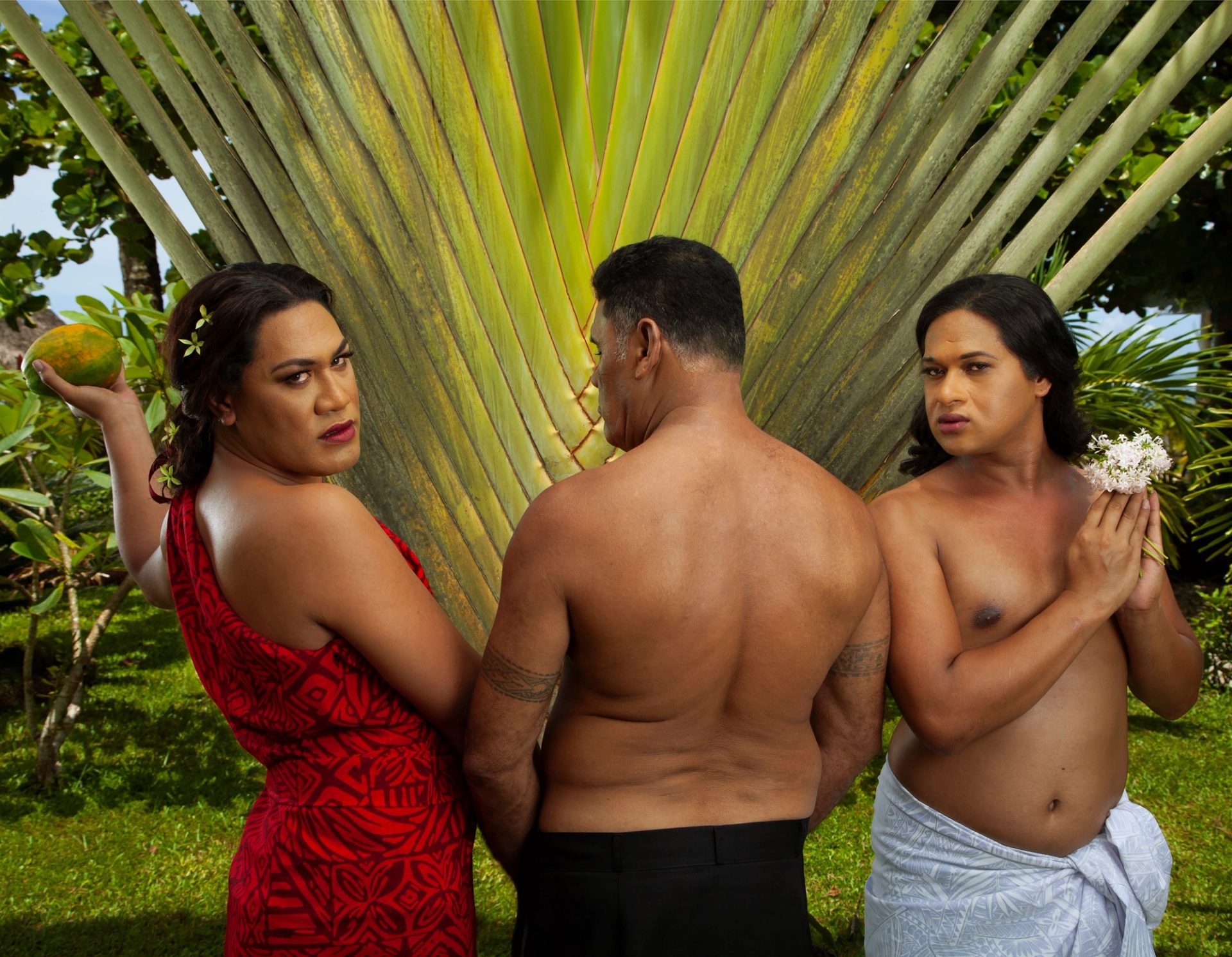
I want to return here to Paradise Camp when it was presented at the Venice Biennale. Paradise Camp at the Venice Biennale was presented within the New Zealand Pavilion, but it almost exclusively featured stories and realities of fa'afafine living in Sāmoa was mostly shot in Sāmoa and worked with over 100 people based in Sāmoa. Here is a good example of when access to the world's biggest stage was afforded via New Zealand status and through Creative New Zealand funding but was upcycled and hijacked and repurposed to represent a fa'afafine nation instead. Similarly, I just want to mention that this Talanoa Forum is one of the few times where I've been in a conference type setting where the majority of people are from around the moana. More often than not, it's really hard to meet with our cousins, our sisters, and our brothers from the Pacific Islands. Trying to bring artists, writers, directors, and curators to Aotearoa, for instance, is much harder than travelling to Europe. There's not a lot of funding available and there's more than a little bit of paperwork. This is a real treat, but it's a treat that I wish was less rare. Knowing who and how we move ultimately reminds us who doesn't.
So, my last provocation that I want to enter into this space is how do we ensure that our movements leave no Sāmoan behind, and how can we move more towards each other rather than away from each other? Thank you.
Lalau Leo Tanoi
‘Art centres quickly became my church, my village.’

Lalau Leo Tanoi Fa'afetai lava and thank you. I was born in 1970 to Sāmoan parents in South Auckland, Māngere. My father's villages, Samatau on his father's father's side and my father's mother's village is Falease'elā. My mother's father's village is Salani, Salesatele, Sapo'e. My mother's mother's villages were Uafato Fagaloa, Lalomauga, Manono and Tanugamanono.
My first exhibition was actually here at the Powerhouse Museum in 1990. I was 20 years old, and I just walked into here and asked for the curator and told them that my family and my father's side were traditional tattooers, and so they jumped at the opportunity for me to represent them here.
So, I just wanted to also talk to you about a lot of the motivation behind my work. I once read a book called Coming of Age in Sāmoa by Margaret Mead. I then further read Professor Derek Freeman's Debunked, the book. What was interesting, I went with Maude Page from the Art Gallery of New South Wales to visit Derek Freeman, and I got to his house in Canberra, ANU. As I went inside, he tried to explain the book to me by telling me, for example, ‘Do you know what a fa'atau means?’ And I just sat there and I didn't know what a fa'atau meant. And it was Sāmoan orators debating over who's going to say thank you. So that was his way, in short, of explaining to me that I'm not Sāmoan in that particular sense.
Driving back home to Sydney – two of my brothers died in a car accident, that's why I left the Cronulla Sharks at that time – but in the back of my mind was what Derek Freeman said to me. So, from that time, I started reading every Sāmoan book you could find at the Sydney University Libraries and that, because I felt that I needed to learn. I didn't really get the opportunity to learn from my father, our Sāmoan culture. He died three months later after my... So again, Derek Freeman's words were still in the back of my mind. So, I was searching, as a Sāmoan in the diaspora, to find out who I was. And so luckily, my family, we were able to further explore my Sāmoan fa'asinomaga, or my identity.
My father wanted me to be a priest, and fortunately we were very naughty boys and instead of learning about Catholicism, we were stealing the money from the church to buy the rest of the kids some food at the bakery. And we were drinking the body and the blood of Christ when father wasn't looking. Art centres quickly became my church, my village. So, I thought, I'm going to learn more about me, and I'm going to learn about centres and the language of contemporary art. Thank you.
Jannike Seiuli
‘I didn't realise that this show [Pacific Runway] would then help me to understand and be proud of who I am and where I come from.’
Jannike Seiuli Pacific Runway started as a fashion show in Campbelltown here in Sydney as a one-off event and I need to thank Leo because from that one off event, he then approached us and said, ‘Hey, I'm working at Casula Powerhouse, we'd love to have you involved in our Pacific Festival that we have at the end of the year’. So, that then started the spark of where it would then continue for three years. And then Lisa Havilah would invite us to Carriageworks, the home of Australian Fashion Week, which was also something very nerve wracking for me because I only saw that it was this show we were doing in our hometown, you know, I didn't see the future of what it would be. And I think one of the trials that I faced was because I was younger, and then as the show started to grow, it was everyone else having a say of, ‘Oh, your models aren't brown enough’, or ‘Their hair is not big enough’, or all these types of things. So, I was trying to grow with the show as well, because I had to then learn to deal with other things and grow tough skin as well, because I thought I was doing the right thing by creating a show for the people, by the people. But with that came also all the comments and everything else. And it was hard for me because I was quite young when I started, so I was trying to keep up with things. As the show grew, I grew and learnt that I couldn't keep everyone happy.
I wanted to touch more so on what Pacific Runway did for me. Everyone sees this grand event, but it was more so a lesson for me to grow into my own skin of being Sāmoan Māori. I was born in New Zealand but grew up here in Sydney. Growing up going to schools that were predominantly Australian, I then had to deal with that – being there was only a few brown kids in our school. We were then the only kids ever asked to perform at multicultural days or produce the multicultural day. As I moved on to my senior years, I was then at a Pacific school, I then felt I wasn't Sāmoan enough amongst these kids. I didn't realise that this show would then help me to understand and be proud of who I am and where I come from. As the years went on, and it was 11 years that we were able to continue this show, it was doing a lot for me on the inside that people didn't realise.
There's a quote that I love by Maya Angelou and [she] says, ‘I come as one and I stand as 10,000’. And that's something that I always would go back to, because it's me standing on the shoulders of my parents, my grandparents, my great grandparents. Thank you.
Tau'ili'ili Alpha Maiava
‘When we left our Hawaiki, what was the sound they brought with them to Aotearoa? As well as what was the origin of music that came with them?’
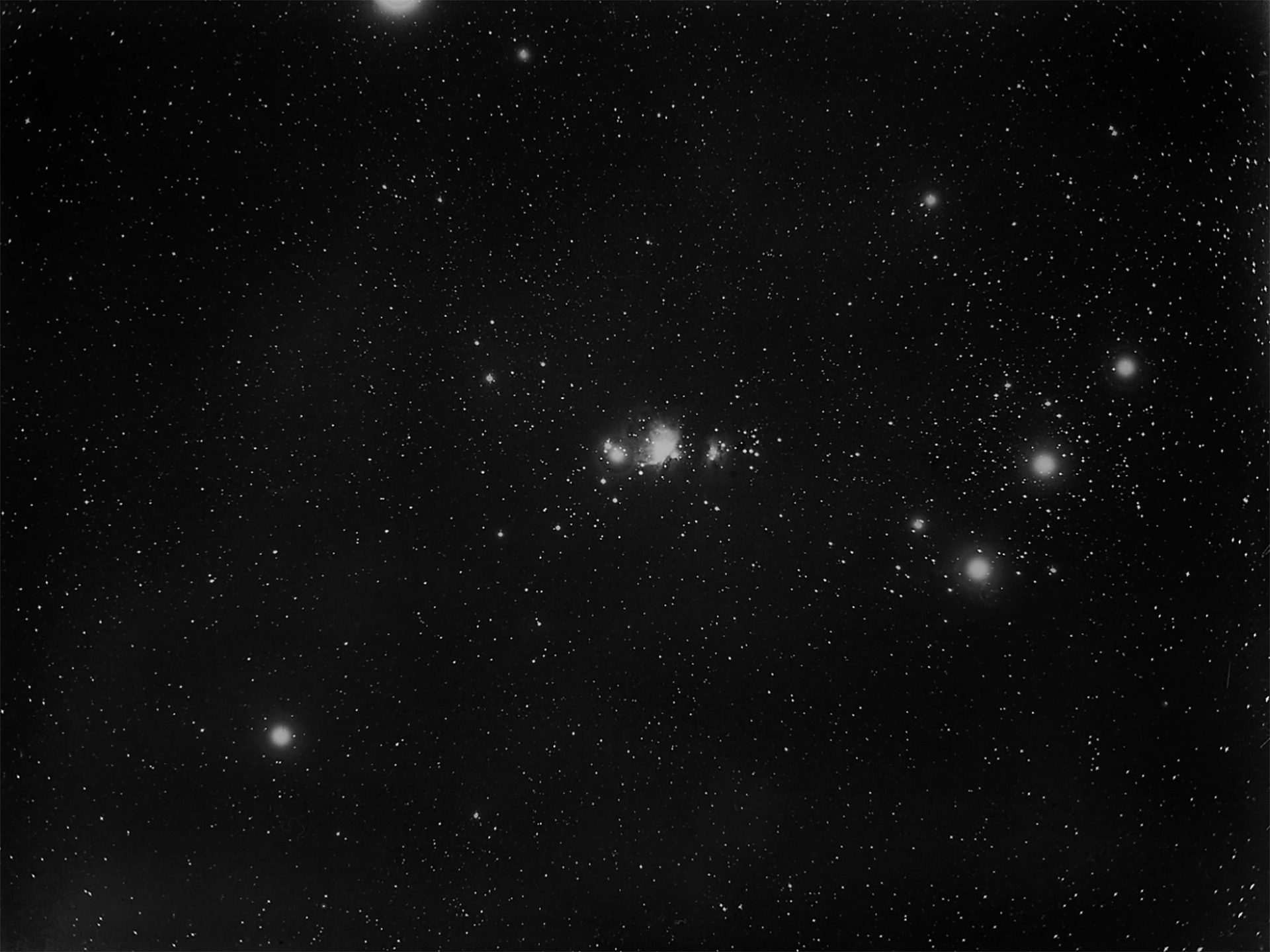
Tau'ili'ili Alpha Maiava I was born into two school of thoughts on Sāmoa. One is called Sa'ili Mālo. In Sāmoa Saili Mālo [is] made up of two words: sa'ili means in search or in pursuit, and mālo, if you say it, mālo it means either the kingdom or something, or a winning that you are in pursuit of. But when you put it together, you are someone in pursuit of something, a greatness, whatever that looks like for somebody. I also grew up in a concept of life of Sāmoa called Tōfā Mamao. Tōfā Mamao, two words. Tōfā means your authority and your wisdom. Mamao means foresight. So that was the two concepts of life that raised me. And so everywhere in life I went I was already into a creative process because to be able to find your way to your winning, you have to be creative.
I was born in a village of Nofoali'i, and I was born into a house that was always Sa'ili Mālō. My father was Sāmoa's first full-blooded pilot, and when my father came back from New Zealand, Sāmoa wouldn't let him fly because he wasn't afakasi or palagi. So, my father went across to American Sāmoa and the palagi couple that used to own an airline called SPIA made my father the captain on day one because they didn't see his skin. It took a palagi to put my father – elevate him – but they saw his qualification. So, to this day, my father is 73, still flying, the longest serving pilot in the Pacific. But that was the house that raised me in the village where I was raised by people that had no ceilings. And if there were, they were meant to be kicked through the teeth.
I am currently contracted to SOUNZ Centre for New Zealand Music. SOUNZ was founded in 1991. It was basically to look after jazz and classical music of Aotearoa. About five years ago they expanded to cover Māori music. Two years ago they decided to expand to cover tagata moana music. You notice I don't use the word Pacific because then I'm giving power to Ferdinand Magellan, who in the 18th century passed by my ocean, who already had a name. So, I'm not a Pacific person. I'm a tagata moana. And we founded it, came together, got a whole bunch of creatives and musicians to tell SOUNZ how we want them to engage with our music. Every time two cultures come together you have to bear fruit: show me the evidence of you marrying each other. So, we decided to build a podcast called Sounds of the Moana, and we had to convince SOUNZ that we're not going to use any academic sources, that we're going to go back and bring up the things they took away from us. Narratives. Pen and paper became the world of the moana. This is how we stop believing the stories of our people. Unless it's written by Adrian Kepler, Richard Moyles or Augustin Kramer. Unbelievable. Why? They never wrote it in a book. And they stole the power of the moana.
We learnt how to read and write. We just didn't read feelings. We read the stars because we were only dedicated to things that had a purpose. And out of that, we engaged for knowledge holders from the Kingdom of Tonga, Viti, and also the Cook Islands and Sāmoa. We wanted to ask them the story, let's look at the sounds of our people when we left our Hawaikis; what was the sound they brought with them to Aotearoa? As well as what was the origin of music that came with them? And out of that, we ended up with Sounds of the Moana, and they enter it into the New York Festival Awards, which is considered the Oscars of podcasting. And we ended up beating BBC, CNN and Lord of the Rings, who had budgets of half a million when ours was $5000.
At the moment I'm currently working on a film. The podcast did so well that they gave us some money to turn everything into a film. I'm working on an eight-part series of tracing eight instruments right across the moana.
We didn't just have musical instruments, they had a purpose in our lives. The stamping tubes: we used it to fish for whales because the vibration under the boat is how they come. It was taken by Captain Cook in 1777. Two of them remain, one in Dublin, one over in the British Museum, cold and lonely and wanting to be used and played. So, if you are a part of a museum, you currently do not allow people to play things from the 1800s. What? You're doing it an injustice. Nose flutes were not created to be displayed. They were created to be played.
What are their stories? I'm not going to refer to a book because we already know. You want a book? Find it in a library or a museum. I want to give back to the people and how our stories were told. And even if they get it wrong, I don't care. It's from the mouths of our people, the thing they took away from us.
Tiumalu Noma Sio-Faiumu
‘Music is a global language and it's used in various areas such as film, television, sports arenas, everywhere. Music infiltrates our existence. For Pacific communities, music serves as a vessel for our stories, our DNA, our measina. It transcends individual ownership.’

Tiumalu Noma Sio-Faiumu My name is Tiumalu Noma Sio-Faiumu. I'm born in my mother's village of Satapuala, Sāmoa. My father hails from Matatafu, and at a very young age my family migrated to Aotearoa where I was raised in South Auckland. South Auckland is home to one of the largest Pacific populations and the youngest populations in the world. In 2014 to 2018 my company, 37 Hz, supported program founders of Anganu'u Fa'a Sāmoa 101. After experiencing the program first-hand, utilising our expertise in programming, tour management, and the power of artistic and creative storytelling, we transformed a 13-week program into an immersive 5-day experience. The program reached the diaspora communities worldwide, including the USA.
I wear many hats and as co-chair for SOUNZ, The Centre of New Zealand Music, and the first board member of Pacific Heritage, part of my role has been to help lead the support and design and implementation of the first known Pacific music strategy for an Aotearoa arts organisation. Before that, we were operating pretty much unregulated, and I really want to acknowledge the great work of Tau'ili'ili Alpha Maiava for responding to the call of feagaiga and supporting me in my work. The strategy led to the creation of digital resources, including animations for the diaspora and also Sounds of the Moana podcast as Alpha first talked about earlier.
Engaging in partnerships with non Sāmoan organisations is necessary for the new world that our diaspora, children and grandchildren are growing up in. But it does come with its unique set of politics and systems and agendas, often driven predominantly by financial considerations. However, our cultural roots are a foundational system that cannot be turned off or compromised. Hence, our Sāmoan systems of tautua and concepts of faasoa and tupua'i and the feagaiga play a keyway in the way that we operate, regardless of Western systems or conflicts of interest. Speaking on conflicts of interest, as the creative producer for the New Zealand Government's apology for the dawn raids era, having to step in and escort the Prime Minister and Minister Mahuta through the cultural processes which underpin the apology was something I wasn't completely comfortable with. One, because I prefer to be behind the scenes. And secondly, as an event producer your head is stuck in the run sheet, and as I was more concerned about the operations and showing people away from the pathways that were preventing the ministers from getting through.
On a personal level, it was a challenge for me as I had to collaborate with one of my siblings, Minister Aupito William Sio, who led the government's apology effort within parliament. Additionally, I also had to work alongside my husband as an avant-garde sound designer who produced the soundscape which amplified the ifoga process. In a Western system, it's referred to as a conflict of interest, but as a Sāmoan, there is no conflict, these are colonial themes. As a Tamai'tai Sāmoa and a matai I am required by the code of feagaiga and the Fraternity of Chiefs to tautua and tapua in my village and my family for significant events and fa'alavelave such as the apology.
Family is a really important thing to me and in closing, my granddaughter, Nala passionately explores the arts at home, at her a'onga a'mata and in our home production studio. My grandchildren are of the diaspora, so they influence a lot of what I choose to advocate for and be involved with. And one of those is the historical injustice that exists within our music industry, due to the way corporations and labels wield the copyright law. This law continues to harm and restrict composers’ access to the lion's share of their own work. And I know we see so many people out there and it looks like they're making it in the music industry. But if we look a little bit deeper behind the scenes, there are massive historical complications. Music is a global language and it's used in various areas such as film, television, sports arenas, everywhere. Music infiltrates our existence. For Pacific communities, music serves as a vessel for our stories, our DNA, our measina. It transcends individual ownership. There really needs to be a comprehensive global review of these laws, because our cultural measina is not protected in the way that it should be in those systems. If we don't, we will continue to perpetuate the system that will continue to enslave not only us but will also burden our descendants with its consequences for today.
Aanoali'i Rowena Fuluifaga
‘The South Pacific has a long history of colonisers and outsiders, imposing their own projections and viewpoints upon the different island nations, rather than seeking a perspective that is authentically engaged with culture, philosophies and experiences of the inhabitants.’
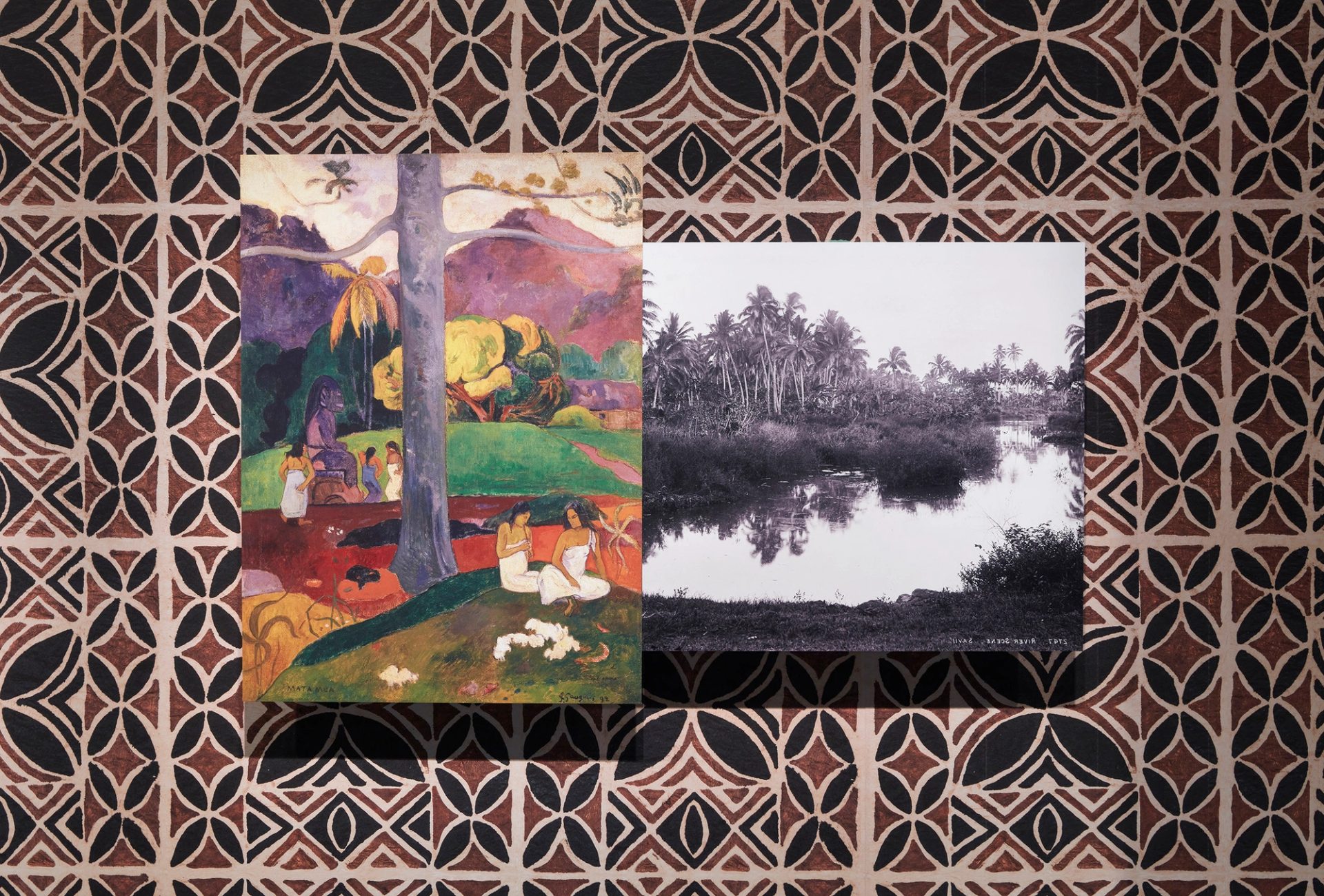
Aanoali'i Rowena Fuluifaga Home for me is when you feel like you've arrived. That place for me is in Aleipata, and it's just coming over the Le Mafa Pass, for those of you who know Upolu, and you literally feel like you've arrived. But once you see the land and you notice the little island off to the side that connects between the south coast of Upolu and Tutuila, I know I've arrived home. But I was born in Auckland.
I've been really privileged in my life to carry the term of an art educator for 20 years in the tertiary sector, and I've been privileged of being appointed the director of Tautai. Tautai is based in Tāmaki Makaurau, Auckland, Aotearoa New Zealand. It's a charitable trust dedicated to championing Pacific arts and artists.
I want to quickly just share my position as a diasporic Sāmoan. And I want also to talk around the notion of vā or the concept of vā and how this has impacted my research and work. Navigating the dualities and complexities of people and Pacific people and the diaspora is a task in itself. And I really appreciate, Ioana, that you talked about those three various things of navigating ourselves in a community where we first always acknowledge our tagata whenua. Also the relationships across our cousins, our various different islands, but also being a minority of Sāmoan diaspora. And I guess that's just the complexity of a lot of us – one of 500,000 Sāmoans in the world.
And my teaching practice is primarily to teach students to discuss their positionality within their first year of understanding context and how it impacts the lens as visual storytellers. ‘E sui faiga, ae tumau le faavae’: the ways of doing may change, but its foundations remain the same. In this presentation I look at how things may look different for Sāmoans across the waters, but the things that also connect us.
I was raised by two wonderful Sāmoan parents in Auckland, and my father, who's passed 20 years now, installed and instilled the value of service. Both he and my mother did. So that is very much part of how I carry myself as a Sāmoan and as a Sāmoan academic. The South Pacific has a long history of colonisers and outsiders, imposing their own projections and viewpoints upon the different island nations, rather than seeking a perspective that is authentically engaged with culture, philosophies and experiences of the inhabitants. Whether it be Paul Gauguin's projection of desire upon the Tahitian landscape and its women, painting an erotic imagery, imaginary for the French bourgeoisie and its Parisian salons; or an Australian tourist snapping a photo of the staff at the hotel where she's been staying, loudly requesting a real Sāmoan smile.
Representations run the risk of being misinformed outside of perceptions rather than of valid internal voice. This was one of the quandaries facing a team of lecturers from Unitec New Zealand in creating a short documentary that chronicles the rebuilding efforts of Poutasi, which is based in the Falealili district of Upolu, in the wake of the 2009 tsunami and the 2013 cyclone. A range of people, both Sāmoan and palagi, have contributed to the rebuild and it's important that their contributions be acknowledged, while at the same time incorporating a filmmaking procedure that is respectful of Sāmoan ethics and philosophies. Such a respect would hopefully express a dynamic experience that emanates from within the village and its residents, rather than just communicate observations from an objective distance. The theme of collaboration constitutes a fundamental foundation for the film. Collaborative efforts in the Poutasi Village, such as an arts centre established by the artist Fatu Feu'u and the High Chief Joe Annandale, together with craft, educational and horticultural initiatives, have become essential elements in reviving social and economic wellbeing for the village.
I collaborated with Joe, forging a memorandum of understanding between Unitec and the village, and a group of Unitec students were privileged to have a village for a classroom for over two weeks, and since that particular year, we've been really fortunate to send students directly into the village of Poutasi.
Such collaborations have been made in the spirit of Sāmoan concept of Teu le Vā cherishing and nursing relationships between people in the village centre or valley, even when participants are separated by stretches of ocean. It is essential to construct an environment in which non-Sāmoan and non-Pacific students and staff would have access to information about Pacific culture and perspectives in order that such an appreciation being integrated into the design process.
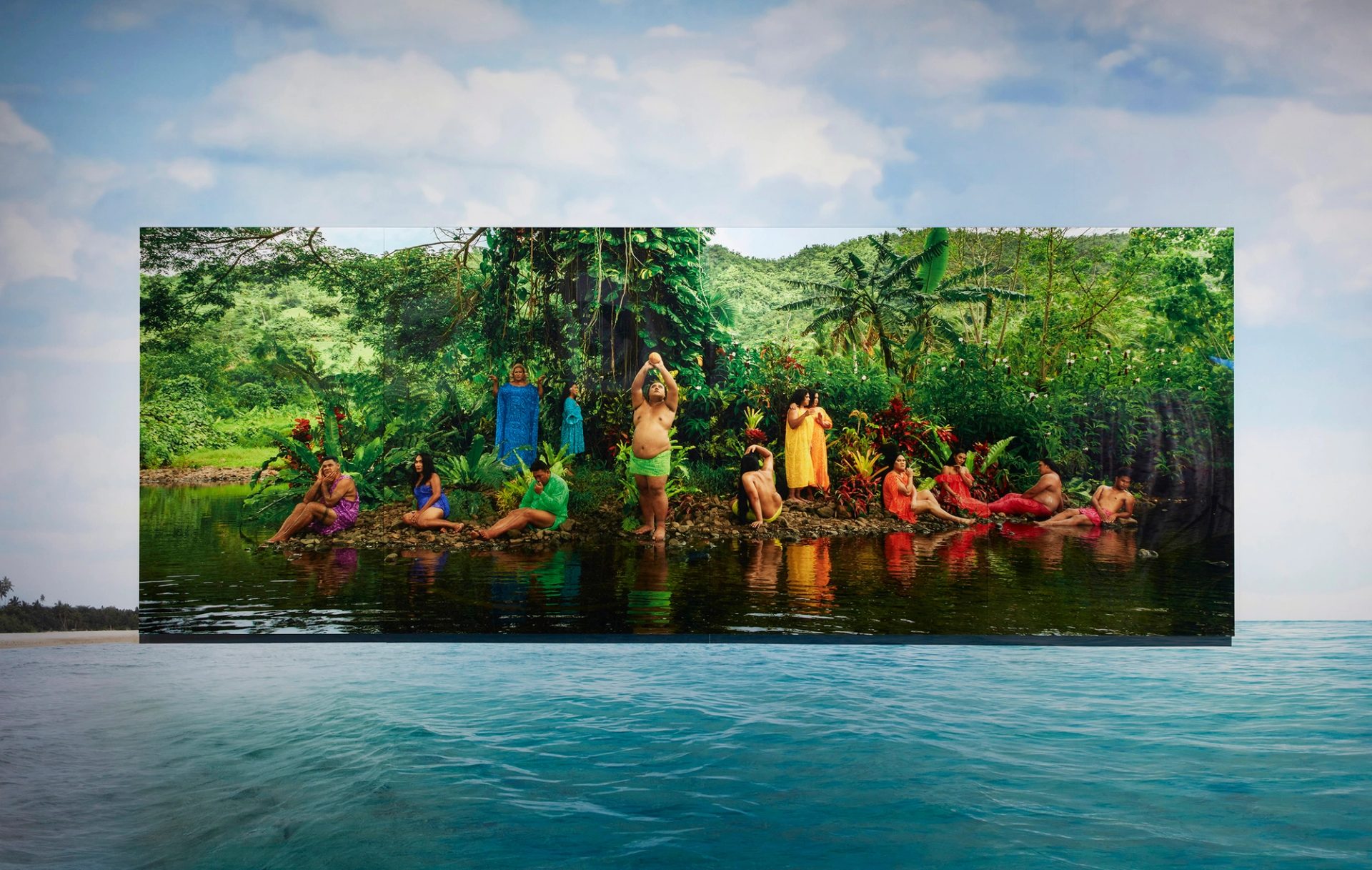
Such an approach and an effort is made to understand a culture from within, through strategies such as research, listening, participation and continuous dialogue, rather than the hoisting of a set of preconceptions upon the observed locale, reflects an attempt to take on broad criticisms from the variety of Pacific voices. Several academics have questioned the ways in which Pacific communities have been depicted through different media presentations in the past and have challenged the Western academic canon for its unwillingness to integrate different cultural worldviews. For instance, Professor Konai Helu Thaman and her 2000 paper Decolonising Pacific Studies: Indigenous Perspectives, Knowledge and Wisdom in Higher Education writes, ‘As a Tongan woman schooled in the traditions of New Zealand and American universities, now working at the University of South Pacific, I have created for myself a philosophy of teaching and learning that is sourced from different cultures and traditions, but rooted in Tongan culture.’ As a teacher who was still a learner, I think Decolonising Pacific Studies is about reclaiming Indigenous, oceanic and moana perspectives, knowledge and wisdom that have been devalued or suppressed because they were not considered important or worthwhile.
Albert Wendt, a Sāmoan-born professor in English literature at the University of Auckland for many years, asks in his paper Tatauing the Post-Colonial Body just what the post-colonial body actually is. He writes, ‘I'm seeing it as a body coming out of the Pacific, not a body being imposed on the Pacific. It is a blend. It is a new development which I consider to be in the heart, spirit and muscle, Pacific. A blend in which influences from outside, even the English language, have been Indigenised, absorbed in the image of local and national, and in turn have altered the national and local.’ Taking on board these insights, our documentary endeavours to intertwine more traditional modes of observational footage with sequences that represent new forms of communication.
I just want to end by saying that this documentary belongs to the nu'u. It was the most exciting part of being an academic is to tautua and to utilise our skills and our research for things that actually contribute back and produce really great outcomes. Thank you.
Speakers
Aanoali'i Rowena Fuluifaga is the director of Tautai Pacific Arts Trust, an organisation dedicated to championing Pacific arts and artists for more than 40 years. A'anoali'i’s own history includes 20 years of working across the tertiary sector in Aotearoa and internationally in education and the arts. Previously, she was an arts educator and lecturer in Theory and Contextual Studies for the Department of Design and Contemporary Arts at Unitec New Zealand. Her research interests include contemporary Pacific art and design, tatau and the Sāmoan notion of vā within an Aotearoa spatial context. A'anoali'i has a master's in philosophy, specialising in women’s hierarchical spaces in rural Sāmoan communities. Her family villages are Vaimoso, Amaile and Solosolo.
Ioana Gordon-Smith is an arts writer and curator of Sāmoan heritage living in Aotearoa. Across her work is a commitment to Moana arts practices and their histories. She has held roles at Artspace Aotearoa, Objectspace, Te Uru Waitākere Contemporary Gallery and Pātaka Art + Museum. Ioana was assistant curator of Yuki Kihara, Aotearoa New Zealand at the 59th Venice Biennale 2022 and co-curator of the international Indigenous triennial, Naadohbii: To Draw Water in Canada. Ioana is co-founder of Marinade: Aotearoa Journal of Moana Art and a trustee for Enjoy Contemporary Art Space, Wellington. As a writer Ioana has contributed to a range of text platforms including publications produced by Thames & Hudson, Routledge, ARP Books and Te Papa Press.
Tau'ili'ili Alpha Maiava is a music composer, vocalist and content creator of Sāmoan-Niuean heritage whose work has an emphasis on Tagata Moana cultural revival and preservation. Tau'ili'ili co-produced and hosted the Sounds of the Moana podcast series which won Gold at the New York Festivals Radio Awards. Much of his work concentrates on building mechanisms to protect and advocate for Moana Pasifika composers through copyrights protection and language empowerment through sounds, including those in the disability space. Tau'ili'ili is currently filming a documentary series on endangered Pacific musical practices Tau'ili'ili was a member of the Mt. Vaea Band when it won Best Polynesian Album at the Hawai'i Music Awards 2005 and had four tracks featured on the Sione’s Wedding soundtrack.
Lalau Leo Tanoi is a foundational figure in Australia's Pacific arts community. He has been many things over the last 20+ years – NRL player, DJ, radio host, events coordinator, creative producer, consultant and curator – and at the centre of history-making programs such as Pacific Wave Festival in the 1990s to the early 2000s and the Body/Mana Pasifika program with the National Rugby League in the 2010s which arguably sparked the flame of Pacific pride that is now the accepted norm within the code. Leo has led projects and curated programs for major institutions including Art Gallery of New South Wales and Casula Powerhouse, and recently created the six-part Treasure Islands web series with Arts and Cultural Exchange and Powerhouse.
Jannike Seiuli is an events dynamo of Māori and Sāmoan heritage elevating the work of Pacific creatives and enterprises through her company, K & D Management. Jannike is also the founder of Pacific Runway, the spectacular fashion showcase of designers, models, makers and stylists of Pacific heritage from across the region. From 2012 to 2022, Pacific Runway grew exponentially from the local RSL to Casula Powerhouse to Carriageworks to Powerhouse Ultimo, challenging fashion stereotypes along the way while indigenising the catwalk (and process). Jannike’s work to generate positive change continues.
Tiumalu Noma Sio-Faiumu is a creative connector of Pacific descent working in the arts cross-culturally and across the social spectrum producing and creating multidisciplinary art projects, both independently and for leading arts organisations. She believes in, and has experienced, how the arts can empower, change and elevate individuals and communities. Noma is managing director of music company, 37 Hz and executive producer of the SOUNZ podcast series Sounds of the Moana, which won Gold (the highest category award) at the prestigious New York Festivals Radio Awards.
About
First presented at the 59th Venice Biennale, the Talanoa Forum extends the themes of the Paradise Camp exhibition by bringing together 24 artists, curators, scholars, activists and policymakers from Australia, Aotearoa New Zealand, Sāmoa, Tahiti and Italy. This 3-day interdisciplinary program highlighted urgent issues including small island ecologies, climate justice, decolonial museology, diasporic and Pacific alliances. The Forum’s artistic director is Yuki Kihara, creator of Paradise Camp.










